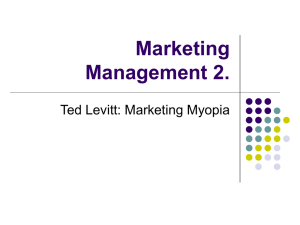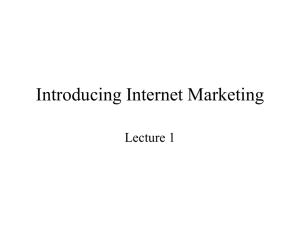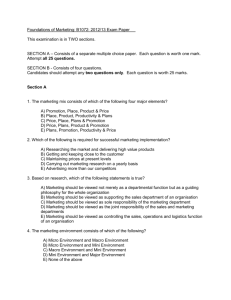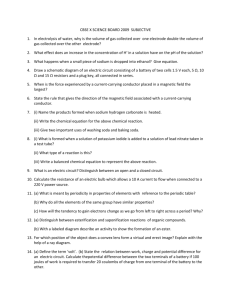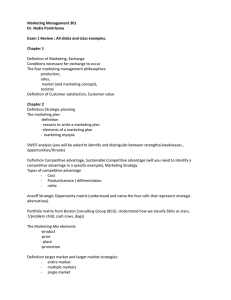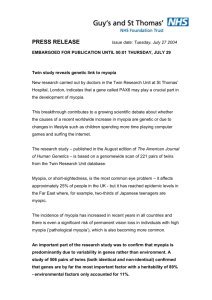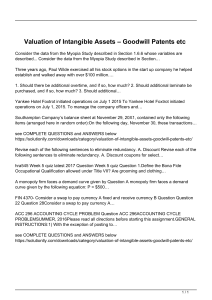279 Role of Jivantyadi Ghruta in management of Progressive Myopia A literary Review
advertisement
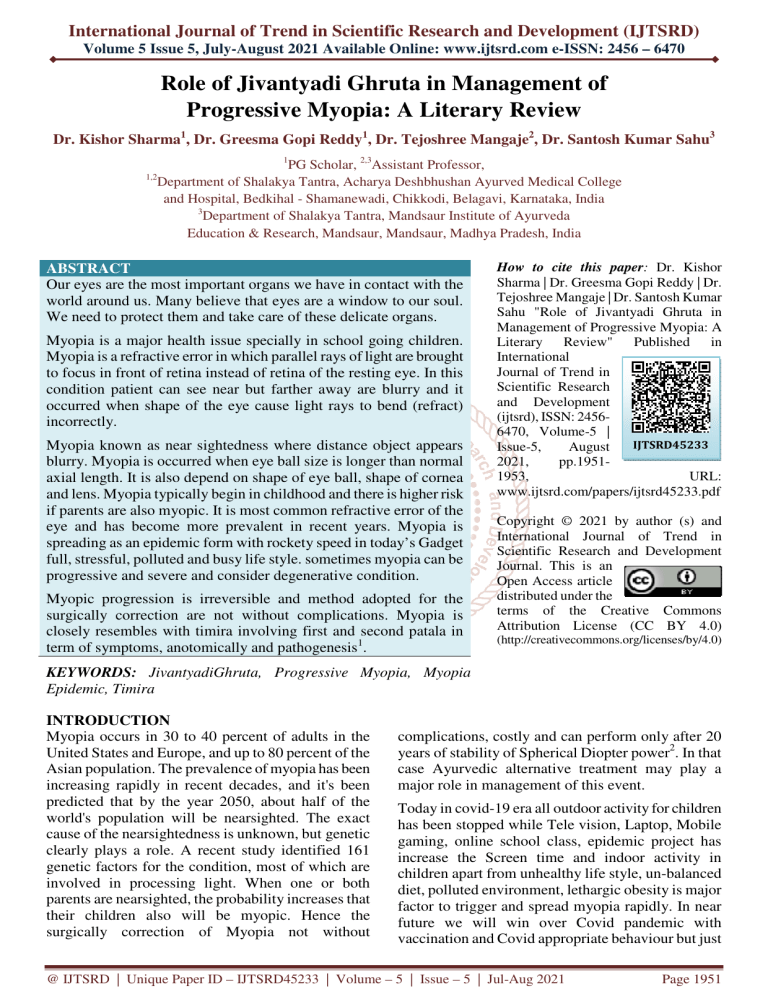
International Journal of Trend in Scientific Research and Development (IJTSRD) Volume 5 Issue 5, July-August 2021 Available Online: www.ijtsrd.com e-ISSN: 2456 – 6470 Role of Jivantyadi Ghruta in Management of Progressive Myopia: A Literary Review Dr. Kishor Sharma1, Dr. Greesma Gopi Reddy1, Dr. Tejoshree Mangaje2, Dr. Santosh Kumar Sahu3 1 PG Scholar, 2,3Assistant Professor, 1,2 Department of Shalakya Tantra, Acharya Deshbhushan Ayurved Medical College and Hospital, Bedkihal - Shamanewadi, Chikkodi, Belagavi, Karnataka, India 3 Department of Shalakya Tantra, Mandsaur Institute of Ayurveda Education & Research, Mandsaur, Mandsaur, Madhya Pradesh, India ABSTRACT Our eyes are the most important organs we have in contact with the world around us. Many believe that eyes are a window to our soul. We need to protect them and take care of these delicate organs. Myopia is a major health issue specially in school going children. Myopia is a refractive error in which parallel rays of light are brought to focus in front of retina instead of retina of the resting eye. In this condition patient can see near but farther away are blurry and it occurred when shape of the eye cause light rays to bend (refract) incorrectly. Myopia known as near sightedness where distance object appears blurry. Myopia is occurred when eye ball size is longer than normal axial length. It is also depend on shape of eye ball, shape of cornea and lens. Myopia typically begin in childhood and there is higher risk if parents are also myopic. It is most common refractive error of the eye and has become more prevalent in recent years. Myopia is spreading as an epidemic form with rockety speed in today’s Gadget full, stressful, polluted and busy life style. sometimes myopia can be progressive and severe and consider degenerative condition. Myopic progression is irreversible and method adopted for the surgically correction are not without complications. Myopia is closely resembles with timira involving first and second patala in term of symptoms, anotomically and pathogenesis1. How to cite this paper: Dr. Kishor Sharma | Dr. Greesma Gopi Reddy | Dr. Tejoshree Mangaje | Dr. Santosh Kumar Sahu "Role of Jivantyadi Ghruta in Management of Progressive Myopia: A Literary Review" Published in International Journal of Trend in Scientific Research and Development (ijtsrd), ISSN: 24566470, Volume-5 | IJTSRD45233 Issue-5, August 2021, pp.19511953, URL: www.ijtsrd.com/papers/ijtsrd45233.pdf Copyright © 2021 by author (s) and International Journal of Trend in Scientific Research and Development Journal. This is an Open Access article distributed under the terms of the Creative Commons Attribution License (CC BY 4.0) (http://creativecommons.org/licenses/by/4.0) KEYWORDS: JivantyadiGhruta, Progressive Myopia, Myopia Epidemic, Timira INTRODUCTION Myopia occurs in 30 to 40 percent of adults in the United States and Europe, and up to 80 percent of the Asian population. The prevalence of myopia has been increasing rapidly in recent decades, and it's been predicted that by the year 2050, about half of the world's population will be nearsighted. The exact cause of the nearsightedness is unknown, but genetic clearly plays a role. A recent study identified 161 genetic factors for the condition, most of which are involved in processing light. When one or both parents are nearsighted, the probability increases that their children also will be myopic. Hence the surgically correction of Myopia not without complications, costly and can perform only after 20 years of stability of Spherical Diopter power2. In that case Ayurvedic alternative treatment may play a major role in management of this event. Today in covid-19 era all outdoor activity for children has been stopped while Tele vision, Laptop, Mobile gaming, online school class, epidemic project has increase the Screen time and indoor activity in children apart from unhealthy life style, un-balanced diet, polluted environment, lethargic obesity is major factor to trigger and spread myopia rapidly. In near future we will win over Covid pandemic with vaccination and Covid appropriate behaviour but just @ IJTSRD | Unique Paper ID – IJTSRD45233 | Volume – 5 | Issue – 5 | Jul-Aug 2021 Page 1951 International Journal of Trend in Scientific Research and Development @ www.ijtsrd.com eISSN: 2456-6470 after we have to face a new epidemic condition that is Progressive myopia in children. So our study about role of Jivantyadi ghruta3 in management of progressive Myopia is more significance. Lot of literature is available for the treatment of eye with herbal formulation in the form of Parisheka (irrigation), Ashchyotana (eye drop), and Anjana (collyrium) forms. Sushruta has enumerated 167 types4 of herbs for the management of different ocular diseases. Propoundrik (Nelumbonucifera) Previously many works have been carried out on efficacy of AkshiTarpana in Myopia with enlarging result but TarpanaPoorvakarma, quite complicated procedure of pradhan karma and pashchyt karma are not too easy and practically possible in patient's day to day life. And also no any study has been yet conducted on practically approachable and convenient method of administration of Chakshushyaghrita in eye in form of ashchyotana (instillation of eye drops). Lodhra (Symplocosracemosa) So in view of the magnitude of the problem, the comfortness of the patients and the low cost of the treatment, there is need to develop a therapy which is free from side effects, cheaper, and has a significant effect in alleviating the symptoms of the patients. This effort is an attempt in this direction to put a break on the progressive Myopia with the Ayurvedic medicine. Material and Method: About the drugJivanti (Leptadeniareticulata) is one of the best rejuvenator plants in Ayurveda. The name itself means that it maintains normal status of health. It found in sub Himalay regions, UP, Punjab, Gujarat and South India. Jivanti has madhur, laghu, shit, snighdh, vaat-pitta shamak quality. It is also a good Chakshushyadravya, rasayan, raktastambhak, grahi, dhatooposhak, reduced burning sensation, inflammation, bruhmanm, beneficial in night blindness and skin disorders5. The Ghrita has the quality of pitta vaathar, rasa shukraojasahitam, mridukrut and vrunaprasadanam. It trespassing into minute channels of the body. Ghruta is made prolong tear film breakup time (TFBUT) and keep moisture in eyes which prevent dryness and CVS (Computer Vision Syndrome) with unique biphasic mechanism of action. Durg preparationFirst we make decoction of Jivanti in 12 litre water heated till reduced approximate 3 litres. For the proportionate of 100 ml preparation 20 ml gokshir and 10 ml ghrut is taken. Than following herbs are taken 12 grams each6- Kakoli (Liliumpolyphyllum) Ksheerkakoli( Liliumpolyphyllum) Haritaki (Terminaliachebula ) Bibhitaki (Terminaliabellirica) Aamalaki (Phyllanthusemblica) Mulethi (Glycyrrhizaglabra) Ashwagandha (Withaniasomnifera) Draksha (VitisVinifera) Pippali (Piper longum) Shatawar (Asparagus racemosus) Daru (Cedrusdeodara) Sandhaw (Rock saalt) Sita (Sugar) All the drugs are mixed and heated till the samyakaghrut siddha lakshana are seen and preparation is made. Mode of action of Ashchyotana7Ghrita is easily trespassing into minute channels of the body. Hence, when applied in the eye, it enters deeper layers of Dhatus and travels every minute part of them. The lipophilic action of Ghrita facilitates the transportation of the drug to the target organ and finally reaching the cell, because the cell membrane also contains lipid. This liphophilic nature of Ghrita facilitates the entry of drug into the eyeball through the corneal surface since the corneal epithelium is permeable to lipid-soluble substances and lipid-soluble substances cross the corneal epithelium irrespective of their molecular size. Ghrita preparation used in ashchyotan is in the form of suspension containing different particles of the drugs and the particles do not leave the eye as quick as a solution. Tissue contact time and bioavailability is more and hence therapeutic concentration can be achieved by ashchyotan. This facilitates the action of drug by allowing more absorption of the drug by the corneal surface and it may changes in the refractive index of the cornea causing less convergence of light rays. Doses and administrationUsually ghruta preparation is sticky and get solidify in winter and cold climate so we does prescribe to administrate single drop in both eyes at bed time in lower fornix at kaninakasandhi (nasal side) because @ IJTSRD | Unique Paper ID – IJTSRD45233 | Volume – 5 | Issue – 5 | Jul-Aug 2021 Page 1952 International Journal of Trend in Scientific Research and Development @ www.ijtsrd.com eISSN: 2456-6470 this area is highly vascularised and absorb maximum amount of drugs. It necessary to melt the eye drop by putting the bottle in luke water for some time. Melting of preparation is also help in administration and doesn't cause any irritation in children eyes. One more benefit or prescribed jivantyadiashchyotan at bed time that children has become a tendency after covid era to awake late night, So our recommendation to put eye drop at between 8pm to 9pm helps parents to go to bed children earlie. It may also help to give up the habits of used gadget by late night. References [1] Curtin B. Topics to be considered when establishing standards for clinical myopia studies. ActaOphthalmol Suppl. 1988. Result and DiscussionAyurvedic treatment is very effective in all kind of eye disorders. Shalakya Tantra eye treatment are noninvasive, safe, Chief, time tested, effective and free from side effects. Shalakya Tantra cure disease from it root causes. Natural drugs used in Shalakya Tantra do not causes harmful effects and treat problems effectively. Shalakya Tantra provides wide range of therapeutic modalities for the management of problems of eye. The therapeutic modalities of Shalakya Tantra based on Ras, Guna, Virya, Vipaka, Prbhava, Karma and Panchmahabhootapredominancy. Jeevantyadighrutaanjanam (instilled as an eye drop) are chakshushya and Vaat-Pitta shamak by its pharmacological constitution and prabhava. [2] Angle J, Wissmann DA. The epidemiology of myopia. Am J Epidemiol. 1980. [3] Vagbhata, AshtangaHridaya – SarvangaSundari Comm. 02-03. Vol. 13. Varanasi: ChaukhambhaSurbhartiPrakashana; 2002. pp. 818–9. [4] SushrutaSamhitaSutrastana 12/10, Hindi Commentary Ayurveda TattvaSandipikawrittenbyKavirajAmbikaduttaS hastripublishedbyChaukhambhaOrientelia, Varanasi- 221005. [5] Vagbhata, AshtangaHridaya – SarvangaSundari Comm. 02-03. Vol. 13. Varanasi: ChaukhambhaSurbhartiPrakashana; 2002. pp. 818–9. [6] Sachitra Shalakya Vigyan, ChaudhariRavindraNath., Dr. 16th edition. GopalMandir Lane, Varanasi: ChaukhambhaOrientalia, 2002. [7] AshuVinayaka, Manjusha R. A clinical study on the efficacy of Tarpana and ShatavaryadiChurna in the management of Timirawsr to Myopia. I. P. G. T. and R. A. 2004. @ IJTSRD | Unique Paper ID – IJTSRD45233 | Volume – 5 | Issue – 5 | Jul-Aug 2021 Page 1953
